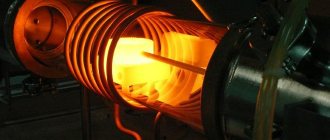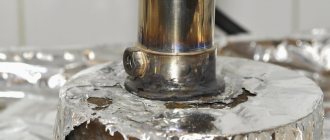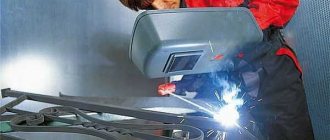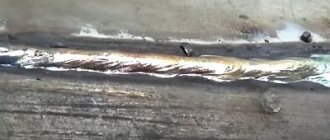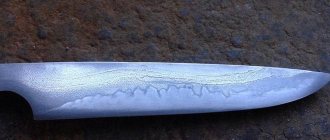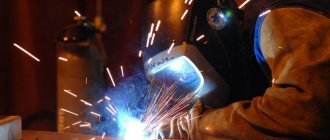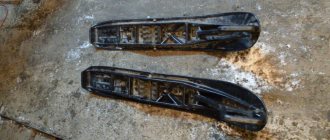Soldering stainless steel is a rather labor-intensive procedure, but it will not cause any special problems if you know all the features of its implementation. With significantly less labor, it is possible to solder stainless steel alloys that contain no more than 25% chromium and nickel. Moreover, soldering stainless steel with such a chemical composition allows you to obtain reliable connections of products from dissimilar metals, excluding alloys with magnesium and aluminum.
Solder repaired bicycle frame
Soldering stainless steel, which contains a significant amount of nickel, can be difficult. This is due to the fact that in such alloys, when heated to a temperature of 500–700°, carbide compounds appear. The intensity of the formation of such connections depends on the duration of heating, so soldering should be performed as quickly as possible.
To minimize the risk of the formation of carbide compounds in the stainless steel structure during soldering, titanium is added to the alloy composition, and after the joint is formed, the product is subjected to heat treatment. You should be very careful when soldering cold-worked stainless steels, the surface of which may become cracked under the influence of heated solder. To avoid such consequences, it is necessary to eliminate the load on the parts being connected during the soldering process. In addition, it is possible to pre-anneal the products being joined.
Use a gas torch for annealing.
The choice of solder with which to solder stainless steel is influenced by both the chemical composition of the alloy and the process conditions. So, if this process is carried out at high ambient humidity, then silver alloys should be used, which contain a small amount of nickel. Soldering in an oven, as well as in a relatively dry atmosphere, is performed using chromium-nickel and silver-manganese solders.
The most common type of flux used when soldering stainless steel is borax, applied to the future joint in the form of a paste or powder. Melting borax on the surface of the parts being joined contributes to uniform and most accurate heating of the area of the future seam to the required temperature - 850°. Only after the required heating temperature has been reached, which can be determined by the color change of the future joint to light red, is solder introduced into the joint between the parts.
The flux is applied in an even layer over the entire surface, which must first be cleaned.
After soldering is completed, flux residues are present at the joint, which are removed by washing with water or sandblasting. To perform this procedure, you cannot use nitric or hydrochloric acids, which, although they effectively clean the flux remaining on the surface of the parts, have a negative effect on both the base metal and the used solder.
How to do soldering at home
Problems such as joining stainless steel parts using soldering and soldering stainless steel to copper are often encountered at home. Products made of stainless steel have been actively used in everyday life for many years, therefore, when for some reason they become unusable, any home craftsman has a natural desire to repair them himself. It should be said right away that soldering stainless steel parts is not so difficult, the main thing is to strictly adhere to the technology, as well as stock up on the appropriate tools and consumables.
Master the soldering technique on simple connections, and then try working with more critical parts
Before you start soldering stainless steel, it is very advisable not only to study the theoretical material on this issue, but also to become more familiar with the rules for its implementation using training videos.
To solder stainless steel products, you will need the following tools and consumables:
- a soldering iron powered by electricity with a power of at least 100 W;
- special soldering acid, which will be used as a flux;
- file or sandpaper;
- solder, specially designed for joining steel parts, based on tin and lead;
- cable made of steel;
- metal tube.
Soldering materials and tools
When choosing a soldering iron for working with stainless steel, you should opt for a tool with a power of 100 W. Using a more powerful device to perform such work is simply not practical.
The process of soldering stainless steel parts is carried out according to the following algorithm.
- First of all, it is necessary to thoroughly clean the area of the future connection, for which sandpaper or a file is used.
- After preparing the surfaces of the parts to be joined, it is necessary to apply flux to them, which, as mentioned above, uses soldering acid. The main task of the flux is to ensure high-quality tinning of the parts to be joined.
- After the surfaces of the parts to be joined are treated with flux, it is necessary to tinning them, which consists of applying a thin layer of solder consisting of tin and lead to them. If tinning was not successful the first time, then it is necessary to repeat this procedure, preheating the parts to be joined.
- Even after heating the products and re-processing them with flux, tinning may not be successful - the solder will simply roll off the surface of the parts, rather than lie on them as a thin film. In this case, you need to use a brush with metal wires, which can be easily made from a tube and steel cable. Before using such a brush, it is also necessary to apply flux (soldering acid) to the surface of the parts and only then, heating the future joint with a soldering iron, clean it with a metal brush. This simple technique allows you to effectively clean the surface of a stainless steel from an oxide film, which, as a rule, is the main obstacle to high-quality tinning.
- Once a thin layer of tin has been applied to the products to be joined, you can begin to solder them. This procedure is performed using a soldering iron and solder, which is used to fill the joint between the parts.
Soldering with a gas torch
The parts are heated using a gas torch or a tin-plated soldering iron tip.
When working with the burner, you must ensure that there is not too much oxygen in the flame, because this causes the stainless steel to oxidize. This can be determined by the color of the fire (it should be blue); if the color is pale and the fire is weak, then this indicates an excess of oxygen. To warm up the connection, the burner must be moved smoothly. By periodically touching the metal with solder, the quality of the temperature achieved is determined. Heating is sufficient when the solder melts not from the flame of the torch, but from touching the metal.
Then solder is immediately applied to the part where the joint needs to be made, while the parts continue to be heated so that the solder, melting, slowly fills the joint completely . If there is not enough liquid solder in some area, it is heated more strongly than other places, and the solder itself flows into it. A clear sign of high-quality soldering is the leakage of excess solder from the joint.
Solder Types
Stainless steel products can be soldered with both soft solders made on the basis of tin and lead, and hard types of filler material, which includes more refractory metals.
Soft solder, due to the fact that it is based on tin, is a low-melting material characterized by high ductility and fluidity in the molten state. What is especially important when soldering stainless steel products is that it has good deoxidizing ability.
Properties of soft solders
More reliable connections both in production and at home can be achieved by soldering using hard solders. The metals from which they are made melt at a higher temperature than tin, which makes it possible to obtain reliable and durable connections with their help. Very often, materials of this type are produced on the basis of technical silver, which can contain up to 30% in their composition.
Main brands of silver solders
One of the popular types of hard solder is the HTS-528 material, which is successfully used for soldering not only stainless steel, but also copper, brass, bronze, nickel and other metals. Conveniently, it is produced in the form of a rod, the surface of which is already covered with a layer of flux. When working with such solder in a production environment or at home, you should keep in mind that its melting point is 760°.
HTS-528 solder is a rod coated with red flux. In addition to stainless steel, it is suitable for cast iron and non-ferrous metals
Low melting point
All are heat resistant, many stainless steels are designed for high temperature loads.
Soft solders are rarely used for soldering. In some cases, soldering is done using tin and lead stainless steel solder. The parts are heated with the flame of a torch or soldering iron. The working parts are dipped into the melt.
In the marking of solders, next to the abbreviation POS there are numbers indicating the tin content. Thus, POS-18 contains 18% tin, up to 2.5% antimony, tenths of a percent of copper, bismuth, arsenic, and the rest is lead.
POS-30 solder includes 30% tin, up to 1.5% antimony, and tiny amounts of copper, bismuth, and arsenic. The rest of the mass is also occupied by lead. The POS-40 composition contains up to 40% tin, about 2% antimony, minor impurities of copper, bismuth, arsenic, and almost 58% lead.
For successful soldering of stainless steels, flux is required. The formation of a good seam is promoted by a mixture of zinc chloride and hydrochloric acid. You can use a 40% solution of orthophosphoric acid in water as a flux.
Sometimes preliminary copper plating by electrolysis makes it easier to solder stainless steel. If an electrolytic installation is available in the access area, the process is not difficult and leads to good soldering.
Flux preparation
When soldering stainless steel, you should be very careful about choosing a ready-made flux or the recipe for making it yourself. The classic flux composition, which can be prepared at home, includes the following components:
- borax (70%);
- boric acid (20%);
- calcium fluoride (10%).
For soldering small-sized products, you can prepare a flux that will consist only of borax and boric acid mixed in equal proportions. Having mixed the components of the flux in dry form, it must be diluted with water and treated with the resulting solution at the site of the future connection.
Choice and its features
There is a huge variety of solders, so everyone can choose the best option for themselves. Hard solders for stainless steel are usually used when the parts will not be exposed to high temperatures or mechanical stress. If no difficulties arise in the future, then it is quite possible to select cheaper materials. Solders that are resistant to alkali and organic acids are usually used in chemical production and industry.
Important! You cannot choose a solder whose melting temperature is lower than the temperature of its use!
Useful tips
To perform stainless steel soldering efficiently, you should use the recommendations of experienced specialists.
- The power of a soldering iron, which must effectively heat the metal being joined, is in the range of 60–100 W, but it is better to opt for a 100-watt device. To solder large parts, such as stainless steel pipes, you will need a gas torch rather than an electric soldering iron.
- When choosing an electric soldering iron, it is better to opt for models equipped with tips that do not burn.
- The most economical and universal type of solder, which makes it possible to obtain high-quality connections for stainless steel products, is tin-lead rods. If you are soldering dishes that will come into contact with food or liquids, it is better to use pure tin as solder, which does not contain harmful impurities.
- The room in which soldering work is carried out must be well ventilated.
- When performing soldering, be sure to use personal protective equipment so as not to harm your health.
Copper
Copper and its alloys are rarely used for soldering stainless steel.
This can only be done at a temperature of 1120 ℃ in specially cleaned, dried, reducing environments. If stainless steels have a high content of chromium, aluminum, silicon and titanium, due to the low fluidity of copper, the process can only be carried out with fluxes in an atmosphere of acetylene and oxygen flame.
In some situations, hard solder is used for stainless steel from copper and zinc with a content of the latter up to 40%. At the same time, solid fluxes are added to the working area.
Such products have disadvantages associated with the possibility of zinc burning. The seam may not be very strong and brittle at high temperatures. The work requires special qualifications of the performer.
Good results are achieved by VPr-1, VPr-, VPr-4, in which copper is the main component. These compositions contain about 30% nickel, up to 2% silicon, up to 1.5% iron, and trace amounts of boron. Using such means, you can solder any stainless steel in furnaces or burner flames.
VPr-41 solder has specific features. It belongs to self-fluxing composites. The functions of fluxes are performed by the addition of potassium, sodium, lithium and phosphorus.
They remove existing oxides, prevent the formation of new oxidation products, and improve the surface tension of the solder. Soldering can be carried out without the use of protective gases under the influence of high-frequency currents, which provide rapid heating.
What else you should know about soldering stainless steel
In cases where special requirements are imposed on soldered joints of stainless steel products, special grades of solders can be used, which include materials based on nickel and phosphorus, as well as nickel, chromium and manganese. Solders of the second group are used, in particular, in cases where soldering is performed in a protective gas environment consisting of a mixture of argon and boron trifluoride. When performing soldering using this technology, pure copper can be used as solder, which wets the metal well and forms a reliable connection.
When using copper solder, the soldering area will differ from stainless steel in a characteristic yellow color
Nickel-based solders make it possible to obtain joints with high strength. However, such materials also have disadvantages, which include low ductility. That is why such filler material is not used to connect stainless steel structural elements that will be subject to shock and vibration loads during their operation. In addition, a soldered seam made of such a material is very critical to low temperatures. Soldering with nickel group solders, which melt at temperatures exceeding 1000°, can be performed in dry hydrogen, argon and vacuum.
Thus, soldering stainless steel products (large pipes operated under pressure, dishes, pieces of furniture or interior design) has its own nuances, which must be taken into account when choosing both soldering modes and consumables. There are many reference books, guided by which, you can optimally select all the necessary materials and obtain a high-quality, reliable and beautiful soldered connection.
Silver
Silver-based solders are widely used for soldering stainless steels. In addition to the noble metal, the mixture includes zinc and copper. Sometimes solder masses are used, which additionally contain nickel, phosphorus, cadmium, and palladium.
Solder for soldering stainless steel with a silver content of 25% to 45% when adding fluxes to the soldering zone guarantees the formation of a strong connection.
The addition of cadmium leads to a decrease in the melting point of the mass, increases its fluidity, and promotes the formation of a strong and plastic seam. It is important to pay attention to the percentage of silver.
If the alloy contains cadmium, then the minimum concentration of the noble metal should be 40%. Otherwise, the quality of the weld on stainless steel will be poor.
The addition of nickel and cadmium increases the fluidity of the melt. The introduction of phosphorus allows you to solder copper-plated surfaces of stainless steel and heat-resistant materials without fluxes, using any heating methods.
This is a convenient method of joining parts with limited access in cases where flux is difficult to use. Remains of the flux mixture cannot be removed from hard-to-reach places.
For special types of soldering of stainless steel, silver solder compositions are used, including up to 15% manganese or up to 28% copper and 0.5% lithium. Soldering of stainless steel with hard solder containing a little lithium is carried out in an environment of inert gases.
Heat-resistant alloys are soldered with this composition using gaseous fluxes. The addition of lithium to the mass increases its wettability and fluidity. Sometimes, to improve the quality of the connection when carrying out the process in an atmosphere of neutral gases, solder mixtures with the addition of palladium are used.
Soldering stainless steel with copper and brass | Soldering stainless steel pipes
Soldering stainless steel is a complex and time-consuming procedure. The fact is that a number of nickel-plated alloys can release carbides when heated to 500 degrees. The amount of release depends on the duration of the soldering process.
The resulting carbides negatively affect stainless steel elements, as they can destroy its anti-corrosion properties. In order to prevent their appearance during soldering of stainless steel, it is necessary to add titanium or carry out additional temperature treatment of the elements.
Soldering of stainless steel must be done after annealing, since when reacting with molten solder, the hardened steel elements may begin to crack.
Work technology
Soldering thin stainless steel has its own characteristics. So, it is necessary to choose solder for stainless parts based on a number of factors:
- steel composition;
- conditions of the soldering process.
Borax is used to process stainless steel. It should be applied to the seam in the form of a powder or paste. When soldering thin stainless steel, the borax begins to melt, and the rest of the material begins to heat up. As soon as the hot temperature is reached - 850 degrees, it is time to introduce solder.
After soldering is completed, it is necessary to remove any material adhering to the stainless steel. To do this, the part must be washed in water or subjected to sand blasting. Similar procedures are carried out during soldering of food-grade stainless steel. However, in this case it is necessary to exclude the use of hydrochloric or nitric acids. They can corrode the base metal or remain on the elements. Soldering food-grade stainless steel is a responsible process that is directly related to the health of people who will subsequently use the soldered product.
